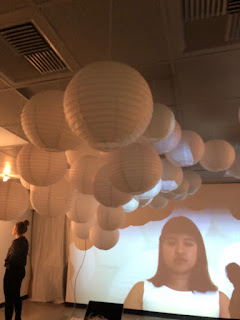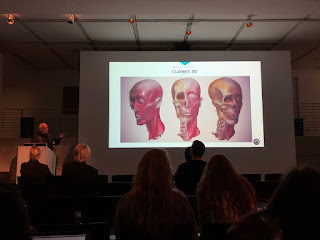EXTRA CREDIT Event #1: Hypnagogia
I attended Chelly Jin's Hypnagogia exhibition, which attracted me as it was about the "liminal state between consciousness and dream" (Jin) This event included a track being played throughout of Jin reading her dreams from the past six years and lights that were created by her consciousness via brainwave sensors, which displays the idea of hypnagogic duality.
Posted along the walls were dreams Jin had and upon further analysis, I saw that the margins of the work had semantic dimensions and scores of each of those semantic dimensions. In one of my communications courses, we worked with a program called LIWC that was a word processor that would give scores to each semantic dimension based on how much your work expressed certain emotions.
This exhibition is a prime example of what Stephen Wilson said in his paper "Myths and Confusion in Thinking About Art/Science/Technology" when he discusses how technology more frequently influences art than art influencing technology. In the case of Jin's work, she was able to utilize technology (brainwave sensors and light) as inspiration and a medium for expressing her hypnagogic state.
Consciousness is topic we know so little about; even physicist Roger Penrose says that we must find a "noncomputational physical process if we're ever to explain the effects of consciousness." Jin's work could be a step towards finding this process through being able to visually express this in-between state of consciousness and a dream.
Attending Jin's exhibition will help me shape ideas for my final project by thinking of the relationship of how technology influences art, and how art influences technology/science (in the case that Jin's work exposes us to physical ways to express consciousness). Furthermore, this makes me think about a part of the prompt where we are asked to see our topic project into the future. Attending this event allowed me to practice thinking of the future implications of Jin's work and what that could mean for art and technology in the future.
 |
| Inside the exhibition |
 |
| One of Jin's dreams. Notice in the margins the semantic dimensions! |
Consciousness is topic we know so little about; even physicist Roger Penrose says that we must find a "noncomputational physical process if we're ever to explain the effects of consciousness." Jin's work could be a step towards finding this process through being able to visually express this in-between state of consciousness and a dream.
Attending Jin's exhibition will help me shape ideas for my final project by thinking of the relationship of how technology influences art, and how art influences technology/science (in the case that Jin's work exposes us to physical ways to express consciousness). Furthermore, this makes me think about a part of the prompt where we are asked to see our topic project into the future. Attending this event allowed me to practice thinking of the future implications of Jin's work and what that could mean for art and technology in the future.
Sources
“The Third Culture - Chapter 14.” Edge, Edge Foundation, www.edge.org/documents/ThirdCulture/v-Ch.14.html.
Jin, Chelly. “HYPNAGOGIA.” UCLA Art | Sci Center, UCLA Art | Sci Center, artsci.ucla.edu/node/1392.
Wilson, Stephen. “Myths and Confusions in Thinking about Art/Science/Technology.” userwww.sfsu.edu/swilson/papers/wilson.caapaper.html.



Comments
Post a Comment